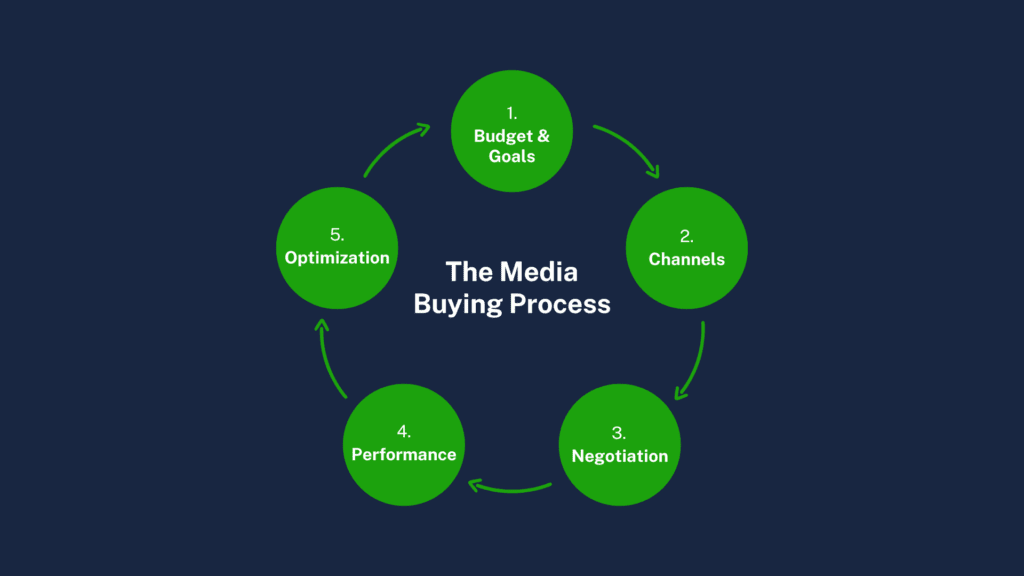This website uses cookies so that we can provide you with the best user experience possible. Cookie information is stored in your browser and performs functions such as recognising you when you return to our website and helping our team to understand which sections of the website you find most interesting and useful.
In today’s competitive hiring landscape, simply posting a job ad and waiting for applicants isn’t enough. Recruiters must be strategic about where, when, and how they advertise to reach the right candidates quickly and cost-effectively. That’s where media buying comes in.
This comprehensive guide covers the essentials of media buying in recruitment, including how it works, how it differs from media planning, and how to build a strategy that delivers results.
What Is media buying in recruitment?
Media buying in recruitment is the execution phase of a recruitment advertising campaign. It is a strategic process in which media buyers purchase or bid for advertising space, track results, and adjust campaigns as necessary. Although this is broadly similar to advertising a product, the advertising platforms differ. For example, job boards, social media recruiting (including LinkedIn advertising), and job ad networks are the primary targets for job ad publication.
What is the difference between media planning and media buying?
Media planning and media buying are closely related but distinct tasks recruiters undertake. During the planning phase, they consider the target markets they hope to reach, campaign objectives, available budget, and the platforms or publications most likely to deliver results.
Media buyers are responsible for executing these plans. Ideally, however, media buying isn’t a passive process, and planning doesn’t end once the strategy is outlined. Instead, media buyers and media planners work together to evaluate results, adjusting plans in order to achieve the desired outcomes.
The media buying process


Media planning and buying often overlap, forming part of a unified process. In many organisations, one person handles both tasks, providing end-to-end control. The typical steps in the media buying process include:
1. Determining budgets and setting goals
Depending on the organisation and the role recruiters hope to fill, they will either be presented with a budget or be asked to define one. Typically, the more senior the position and the rarer the skills, the higher the budget required to source qualified candidates. The number of applicants needed also plays a role in shaping the overall media spend.
Key goals include target conversion rates per ad, the volume of qualified candidates, and demographic reach to support broad-based hiring. Timelines are also crucial—longer time-to-hire increases costs and can negatively affect the candidate experience.
2. Selecting the right channels
Goal-fulfilment is strongly related to channel selection. To attract a specific candidate profile, it’s essential to place ads where your target audience is most active. Some advertising platforms have broad reach, while others target specific professions or demographics. For example, job boards focused on specific industries, or those targeting groups such as women or younger candidates.
Similarly, social media platforms can also vary in relevance depending on the role. A makeup brand recruiting sales representatives might prioritise Instagram, whereas roles in product formulation or manufacturing may call for more specialized or professional platforms.
3. Negotiating and purchasing media
Some advertising prices are standardized, and costs may not be negotiable. For instance, if you wish to place print advertisements, the price depends on the placement and the amount of space your advertisement occupies. Other platforms may charge for the time an advertisement appears, operate on the basis of reach (for example, social media advertising), or work on a pay-per-click basis.
In cases where pricing is negotiable, ads are often purchased through a bidding process. Tools like Broadbean’s media platform allow recruiters to set their desired budget, choose specific platforms, or receive automated recommendations. The bidding and purchasing process is handled programmatically, enabling buyers to run campaigns across multiple channels with minimal manual input.
4. Monitoring performance
There are two primary reasons for monitoring ad performance. First, if an ad isn’t attracting applicants effectively, it may be best to switch platforms without delay. Second, identifying which platforms deliver the best results will inform and improve future campaigns. A programmatic advertising platform that integrates with your applicant tracking system (ATS) should allow you to track applicant sources accurately.
5. Optimizing campaign spend
Getting the best possible results within your budget is a priority. Using your ad monitoring data, you can optimize your campaign spend by using real performance data to guide any adjustments you wish to make. If you are achieving a comparatively low response rate and a high cost per candidate on certain platforms, you can shift investment to platforms that perform well. Alternatively, you can seek fresh options that may expand your reach and yield better results.
Types of media buying in recruitment
When deciding how to use your budget, you should consider the different types of media buying available and allocate funds according to your priority channels. Listed by category, these include:
Direct buys
You will encounter this category when advertising in print publications and occasionally on specialized job boards. Quite simply, you contact the publisher and buy the advertising space. Often, the cost remains the same regardless of the position you advertise or the results you achieve. This approach is best used when targeting local publications, when advertising in specialized publications, or when targeting specialized job boards.
Programmatic media buying
Using specialized software, media buyers input their desired criteria, including budgets, and allow the software to bid on advertising opportunities that match the selected parameters. This may have advantages like allowing access to a wider range of jobs boards and niche sites catering to your prospective applicant pool.
Social and search ad placements
These can be complex to navigate. Beyond selecting the right social media platforms, it’s important to consider the level of competition in your niche. For example, LinkedIn ads are displayed based on whether they are paid or organic, and SEO principles still apply.
Similarly, relevant keywords will be vital to search engine ad placement. Since job boards often pay for high rankings, your ad may end up competing with them, potentially reducing its visibility. This type of advertising is best used for jobs requiring very niche skills.
Key benefits and considerations
Companies invest in media buying because they cannot afford to delay the search for new recruits. Within media buying, both direct buying and programmatic buying offer ways to quickly reach targeted talent pools across a range of platforms.
With the right strategies to guide you, you can present hiring managers with qualified candidates faster, reduce time to hire, and use your budgets to your best advantage.
The key considerations are finding the right candidates within the right time frame and at the right advertising cost. When done well, media buying can play a pivotal role in shaping your overall hiring strategy and outcomes.


Common mistakes to avoid
There are several pitfalls to watch out for when planning strategies and executing media buying activities. Some of the most common mistakes include:
Over-reliance on a single channel
A strong media buying strategy should aim to attract both active and passive job seekers. While active candidates are likely to browse job boards, passive candidates may never see your and if that’s the only place it appears. Relying too heavily on a single channel limits your reach and reduces your chances of connecting with top talent. As a result, you may miss out on ideal candidates simply because they weren’t exposed to the opportunity.
Not reviewing results regularly
Failing to review results could mean that part of your advertising spend is unproductive. With online advertising, this could mean paying daily advertising rates for an ad that performs poorly. Compare results across platforms and remember to consider both the quantity and quality of candidates you are attracting from each ad placement. For example, an ad that attracts a small number of highly relevant candidates may offer more value than one that draws a large volume of unsuitable applicants.
Poor messaging
A weak job advertisement won’t deliver the same results as a well-crafted one. Poor campaign performance doesn’t always reflect a flawed design or execution—it may come down to the messaging. To attract quality candidates, implement best practices for job ads, including salary transparency and a strong employee value proposition. While some job seekers may apply to any role, top candidates are drawn to opportunities that excite and inspire them.
Buying media without a strategy
Your media buying strategy defines who you are trying to reach, the budget available, and the best approach to take. Without one, your efforts risk being a hit-or-miss at best and ineffective at worst. A solid strategy also sets clear goals, outlines the channels to use, and ensures resources are aligned for maximum impact.
Media buying is important in every business’s overall strategy
Businesses implement strategies to achieve important goals like profitability and market leadership. Executing these strategies requires the right people. Attracting talent quickly and cost-effectively directly supports business performance, highlighting the value of a smart media buying strategy.
Just as media buying for products drives brand growth, recruitment media buying helps you find the talent your business needs to succeed. Programmatic media buying, though not the be-all and end-all of your strategy, saves you time and money while strengthening outcomes.
Explore our media buying services and feel free to request a demo. We’d love to show you how we can help you work smarter and boost your recruitment campaign results.

